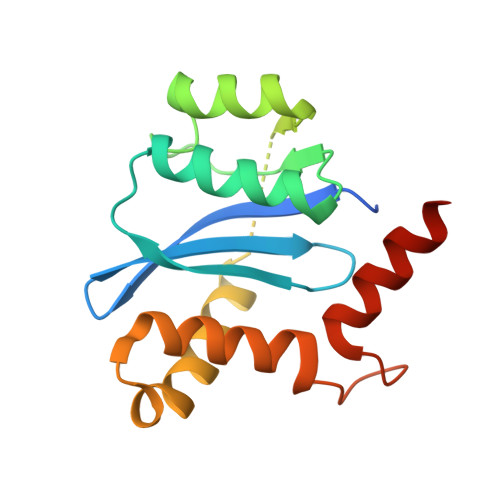GRL-142 binds to and impairs HIV-1 integrase nuclear localization signal and potently suppresses highly INSTI-resistant HIV-1 variants.
Aoki, M., Aoki-Ogata, H., Bulut, H., Hayashi, H., Takamune, N., Kishimoto, N., Tanaka, H., Higashi-Kuwata, N., Hattori, S.I., Das, D., Venkateswara Rao, K., Iwama, K., Davis, D.A., Hasegawa, K., Murayama, K., Yarchoan, R., Ghosh, A.K., Pau, A.K., Machida, S., Misumi, S., Mitsuya, H.(2023) Sci Adv 9: eadg2955-eadg2955
- PubMed: 37436982
- DOI: https://doi.org/10.1126/sciadv.adg2955
- Primary Citation of Related Structures:
7UE1 - PubMed Abstract:
Nuclear localization signal (NLS) of HIV-1 integrase (IN) is implicated in nuclear import of HIV-1 preintegration complex (PIC). Here, we established a multiclass drug-resistant HIV-1 variant (HIV KGD ) by consecutively exposing an HIV-1 variant to various antiretroviral agents including IN strand transfer inhibitors (INSTIs). HIV KGD was extremely susceptible to a previously reported HIV-1 protease inhibitor, GRL-142, with IC 50 of 130 femtomolar. When cells were exposed to HIV KGD IN-containing recombinant HIV in the presence of GRL-142, significant decrease of unintegrated 2-LTR circular cDNA was observed, suggesting that nuclear import of PIC was severely compromised by GRL-142. X-ray crystallographic analyses revealed that GRL-142 interacts with NLS's putative sequence (DQAEHLK) and sterically blocks the nuclear transport of GRL-142-bound HIV KGD 's PIC. Highly INSTI-resistant HIV-1 variants isolated from heavily INSTI-experienced patients proved to be susceptible to GRL-142, suggesting that NLS-targeting agents would serve as salvage therapy agents for highly INSTI-resistant variant-harboring individuals. The data should offer a new modality to block HIV-1 infectivity and replication and shed light on developing NLS inhibitors for AIDS therapy.
Organizational Affiliation:
Experimental Retrovirology Section, HIV and AIDS Malignancy Branch, National Cancer Institute, National Institutes of Health, Bethesda, MD, USA.
















